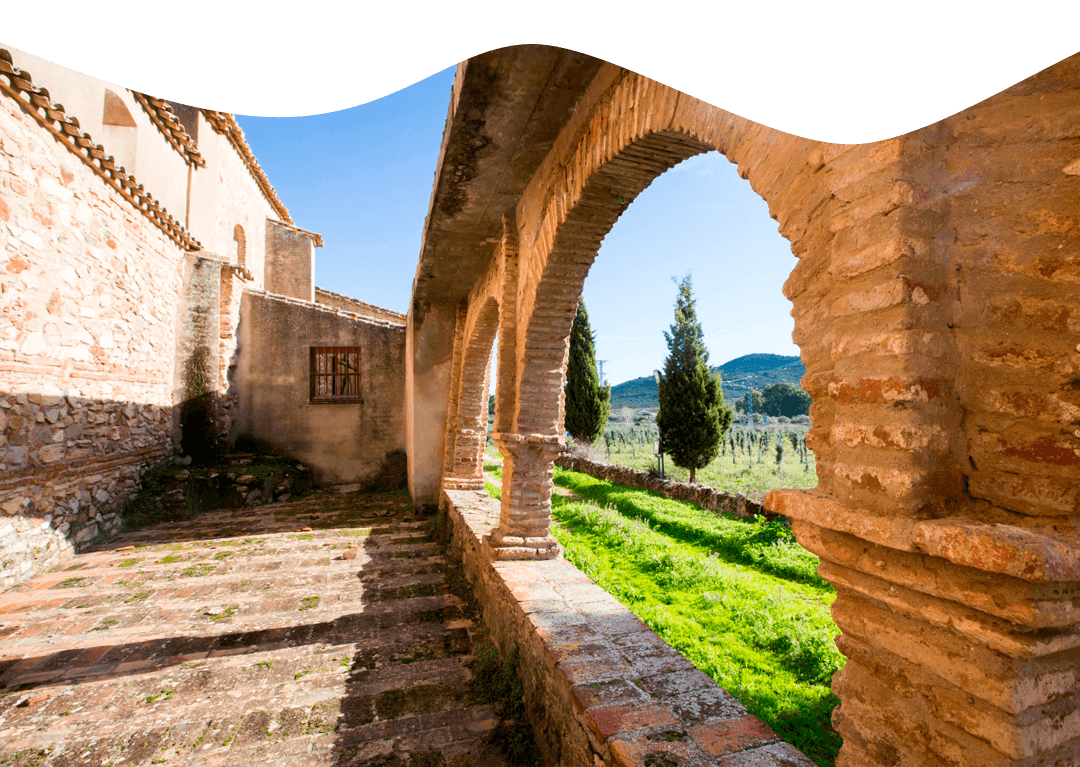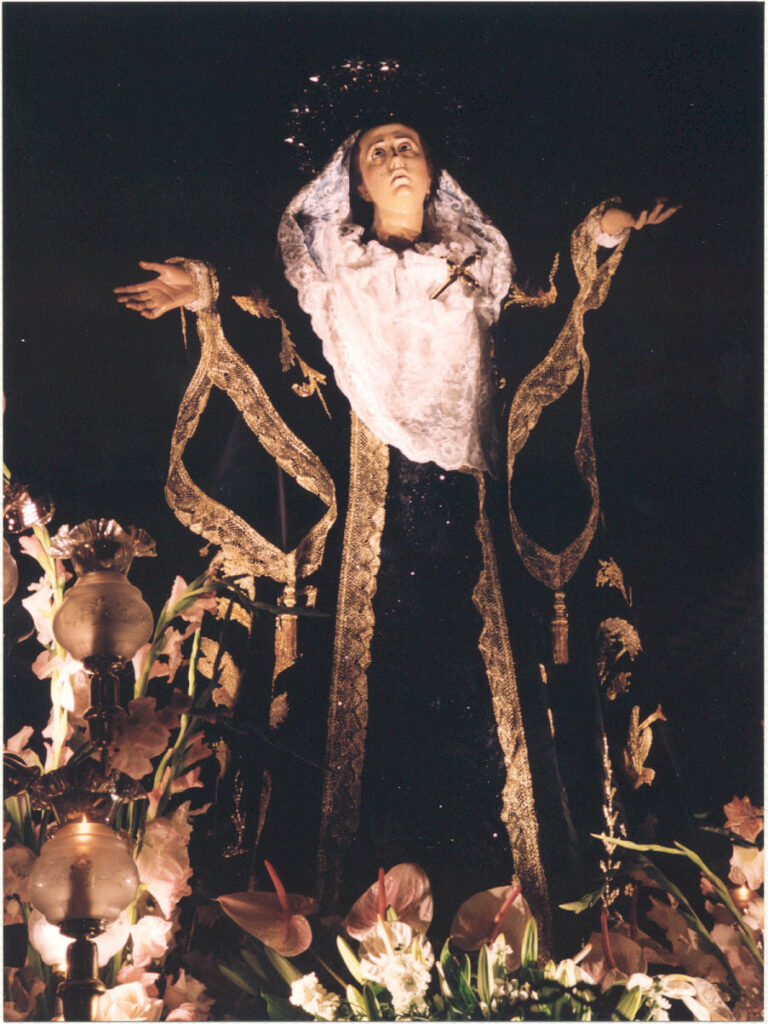

La Semana Santa de Archena fue declarada Fiesta de Interés Turístico Regional en 1995. El Cabildo Superior de Cofradías está integrado por doce Cofradías y Hermandades que son las que organizan todos los desfiles procesionales.
Tras los triduos y distintos actos cuaresmales que comienzan el miércoles de ceniza, los actos de la Semana Santa archenera se inician el domingo anterior al de Ramos, con el Pregón de Semana Santa que siempre tiene lugar en la Iglesia Parroquial de San Juan Bautista, tras la misa de doce. Las primera de las procesiones que organizan las distintas cofradías y hermandades es la del Viernes de Dolores, el Vía Crucis, y en ella desfila únicamente la Virgen de los Dolores, con su trono e imagen correspondiente.
El Domingo de Ramos, a las diez de la mañana, tiene lugar la procesión de las palmas; finalizada la cual se celebra la Santa Misa. La adquisición de palmas para el domingo de Ramos, que luego se repartían entre los vecinos, ha sido durante siglos uno de los gastos fijos del Ayuntamiento de Archena. Actualmente es el Cabildo, que cuenta con subvención municipal, el que se encarga de su compra.
El Lunes Santo no hay procesión, pero sí un Vía Crucis organizado por la Cofradía de las Ánimas, que sale de noche desde la Parroquia del Corpus Christhi. El Martes Santo, los archeneros sacan a la calle la Procesión del Perdón, que es la primera que se inicia ya en horario nocturno e incluye los siguientes tronos: la Oración del Huerto, la Negación de San Pedro, el Jesús del Rescate, el Cristo de los Azotes, el Cristo del Perdón, La Piedad y la Soledad. El Miércoles Santo, la Procesión del Prendimiento lleva a las principales calles del centro de Archena ocho tronos, que en buena parte escenifican la pasión de Jesucristo. La emblemática Cruz de los Espejos inicia el desfile, seguida del Ecce Homo, la Centuria romana, conocida popularmente como compañía de los Armaos, el Cristo del Gran Poder, el Cristo de la Agonía, el Cristo de la Sangre, San Juan Evangelista, y finalmente La Dolorosa.


El Jueves Santo, rememorando ya la muerte del Salvador, podríamos decir que no hay procesión, porque la llamada Procesión del Silencio y Vía Crucis, sale exactamente a las 24.00 horas, desfilando un único trono, el del Cristo del Monte Calvario, por lo que en realidad es una de las tres que corresponden al Viernes Santo.
Ese es el día fundamental en la Semana Santa de Archena, sin duda el más emocionante y agotador para los hermanos y cofrades, que además de la señalada, sacan otras dos procesiones a la calle. A las nueve de la mañana se produce el llamado Encuentro Doloroso posteriormente el Sermón de Semana Santa en la Plaza de España, tras el que inicia su recorrido la más larga, La Procesión del Encuentro Doloroso, integrada por trece tronos: la Cruz de los Espejos, la Samaritana, la Cena, la Oración del Huerto, el Cristo de los Azotes, la Verónica, Nuestro Padre Jesús Nazareno, la Centuria Romana (los Armaos), el Cristo del Gran Poder, el Cristo de la Agonía, el del Monte Calvario, San Juan Evangelista y La Dolorosa.
Al término de los oficios tiene lugar una ceremonia singular: el desenclavamiento, del Cristo Crucificado, que posteriormente desfila tumbado sobre el sepulcro El autor de esta talla es el único escultor archenero, Enrique Salas, artífice igualmente de la Cruz de los Espejos. Desde las nueve y media de la noche llenan las calles de Archena las tallas, flores, luces y penitentes que conforman la Procesión del Santo Entierro. Va precedida como es habitual por la Cruz de los Espejos, a la que siguen el Cristo de la Sangre, María Magdalena, el Cristo del Perdón, el Descendimiento, La Piedad, la Cruz de la Escalera, el Santo Sepulcro, los Armaos, San Juan Evangelista y La Dolorosa.
Tras la apoteosis procesional del Viernes Santo, el Sábado solo se organiza una Vigilia Pascual.
El Domingo de Resurrección, es, lógicamente, el día más festivo y alegre. A primera hora de la mañana tiene lugar el Encuentro Glorioso entre San Juan, la Virgen, María Magdalena, la Cruz y el Resucitado, produciéndose el baile de los pasos que llevan los llamados “anderos”, y la suelta de palomas y globos entre una auténtica lluvia de caramelos.
Posteriormente la Procesión del Resucitado, en la que participan los citados tronos, pone el broche final a la Semana Santa archenera.


Cofradía de la Santísima Cruz de los Espejos
Fundada: finales S. XIX
Pasos: Santísima Cruz de los Espejos, San Pedro
Atuendo: blanco
Cofradía de la Verónica, Cristo de la Sangre y la Samaritana
Fundada: 1943
Pasos: La Verónica, Stmo. Cristo de la Sangre, La Samaritana
Atuendo: rojo
Real Cofradía del Stmo. Cristo del Perdón
Fundada: 1947
Pasos: Stmo. Cristo del Perdón, Cristo amarrado a la columna, La Oración del Huerto, Stma. Virgen de la Soledad
Atuendo: rojo y negro
Cofradía del Santísimo Cristo del Gran Poder
Fundada: 1988
Pasos: Santísimo Cristo del Gran Poder, Descendimiento de Jesús
Atuendo: negro y dorado
Cofradía del Santísimo Cristo de la Agonía y Stma. María Magdalena
Fundada: 1994
Pasos: Stmo. Cristo de la Agonía, Stma. María Magdalena
Atuendo: terciopelo granate
Cofradía del Santísimo Cristo del Monte Calvario
Fundada: 1960
Pasos: Cristo Crucificado (articulado), Cruz de la Escalera
Atuendo: amarillo y morado
Cofradía de Ánimas
Fundada: 1774
Pasos: Nuestro Padre Jesús Nazareno, Ecce Homo, Santa Cena, Santo Sepulcro
Atuendo: morado
Hermandad de Cristo Resucitado
Fundada: Finales S. XIX
Pasos: San Juan Evangelista
Atuendo: verde y rojo
Cofradía Nuestra Señora del Consuelo y Santas Mujeres de Jerusalén
Fundada: 1778
Pasos: Virgen de los Dolores
Atuendo: azul
Hermandad de Nuestro Padre Jesús Nazareno y Santo Sepulcro
Fundada: 2002
Pasos: Stmo. Cristo de las Ánimas
Atuendo: blanco roto y negro
Hermandad de San Juan Evangelista
Fundada: 1954
Pasos: Cristo Resucitado
Atuendo: blanco y oro
Hermandad de la Santísima Virgen de los Dolores
Fundada: 2013
Pasos: Nuestra Señora del Consuelo y Santas Mujeres, Santa María de Cleofás y Santa María Salomé
Atuendo: negro y rosa
We firmly believe that the internet should be available and accessible to anyone, and are committed to providing a website that is accessible to the widest possible audience, regardless of circumstance and ability.
To fulfill this, we aim to adhere as strictly as possible to the World Wide Web Consortium’s (W3C) Web Content Accessibility Guidelines 2.1 (WCAG 2.1) at the AA level. These guidelines explain how to make web content accessible to people with a wide array of disabilities. Complying with those guidelines helps us ensure that the website is accessible to all people: blind people, people with motor impairments, visual impairment, cognitive disabilities, and more.
This website utilizes various technologies that are meant to make it as accessible as possible at all times. We utilize an accessibility interface that allows persons with specific disabilities to adjust the website’s UI (user interface) and design it to their personal needs.
Additionally, the website utilizes an AI-based application that runs in the background and optimizes its accessibility level constantly. This application remediates the website’s HTML, adapts Its functionality and behavior for screen-readers used by the blind users, and for keyboard functions used by individuals with motor impairments.
If you’ve found a malfunction or have ideas for improvement, we’ll be happy to hear from you. You can reach out to the website’s operators by using the following email
Our website implements the ARIA attributes (Accessible Rich Internet Applications) technique, alongside various different behavioral changes, to ensure blind users visiting with screen-readers are able to read, comprehend, and enjoy the website’s functions. As soon as a user with a screen-reader enters your site, they immediately receive a prompt to enter the Screen-Reader Profile so they can browse and operate your site effectively. Here’s how our website covers some of the most important screen-reader requirements, alongside console screenshots of code examples:
Screen-reader optimization: we run a background process that learns the website’s components from top to bottom, to ensure ongoing compliance even when updating the website. In this process, we provide screen-readers with meaningful data using the ARIA set of attributes. For example, we provide accurate form labels; descriptions for actionable icons (social media icons, search icons, cart icons, etc.); validation guidance for form inputs; element roles such as buttons, menus, modal dialogues (popups), and others. Additionally, the background process scans all of the website’s images and provides an accurate and meaningful image-object-recognition-based description as an ALT (alternate text) tag for images that are not described. It will also extract texts that are embedded within the image, using an OCR (optical character recognition) technology. To turn on screen-reader adjustments at any time, users need only to press the Alt+1 keyboard combination. Screen-reader users also get automatic announcements to turn the Screen-reader mode on as soon as they enter the website.
These adjustments are compatible with all popular screen readers, including JAWS and NVDA.
Keyboard navigation optimization: The background process also adjusts the website’s HTML, and adds various behaviors using JavaScript code to make the website operable by the keyboard. This includes the ability to navigate the website using the Tab and Shift+Tab keys, operate dropdowns with the arrow keys, close them with Esc, trigger buttons and links using the Enter key, navigate between radio and checkbox elements using the arrow keys, and fill them in with the Spacebar or Enter key.Additionally, keyboard users will find quick-navigation and content-skip menus, available at any time by clicking Alt+1, or as the first elements of the site while navigating with the keyboard. The background process also handles triggered popups by moving the keyboard focus towards them as soon as they appear, and not allow the focus drift outside of it.
Users can also use shortcuts such as “M” (menus), “H” (headings), “F” (forms), “B” (buttons), and “G” (graphics) to jump to specific elements.
We aim to support the widest array of browsers and assistive technologies as possible, so our users can choose the best fitting tools for them, with as few limitations as possible. Therefore, we have worked very hard to be able to support all major systems that comprise over 95% of the user market share including Google Chrome, Mozilla Firefox, Apple Safari, Opera and Microsoft Edge, JAWS and NVDA (screen readers), both for Windows and for MAC users.
Despite our very best efforts to allow anybody to adjust the website to their needs, there may still be pages or sections that are not fully accessible, are in the process of becoming accessible, or are lacking an adequate technological solution to make them accessible. Still, we are continually improving our accessibility, adding, updating and improving its options and features, and developing and adopting new technologies. All this is meant to reach the optimal level of accessibility, following technological advancements. For any assistance, please reach out to
